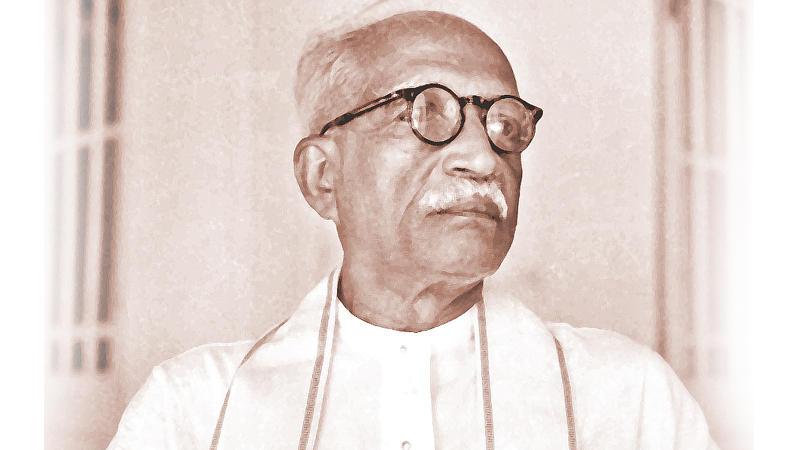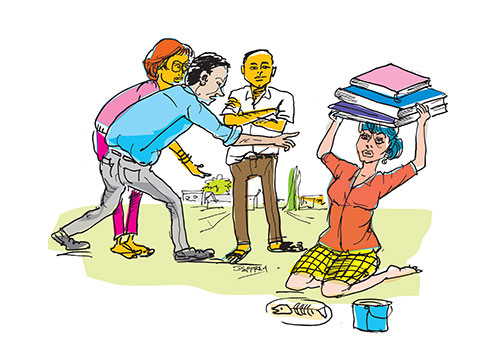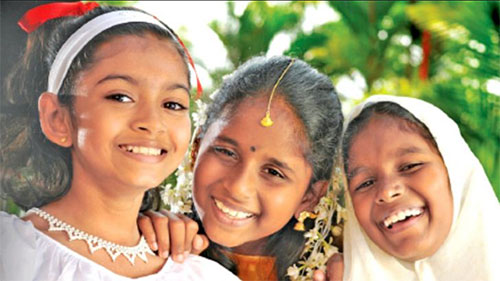By Sasindu Patabendige
Aragalaya which is/can be (mis)translated to English as ‘struggle’ or ‘revolt’ is getting suppressed and appropriated in multiple ways at the time of writing this piece, ironically (perhaps), with the sanction of the de facto president who claims to be ‘liberal’ and ‘democratic’. The attempt of this column is to present some scattered readings about the current interregnum, as it were, while trying to learn to draw insights from it which might be useful for long-term tasks of/for the future.
Those of ‘us’ in ‘academic circles’ (no matter how progressive we think we are) should constantly keep reminding ‘ourselves’ of the provocative insight that “the street is always two steps ahead of theory” in order to guard ‘ourselves’ against top-down and/or vanguardist tendencies. Generalising and romanticising the street will lead to misnomers and oversimplifications. That is to say, it is dangerous to underestimate the adeptness of the “politico class” and it is equally dangerous to overestimate, generalise and romanticise the “people”. At the same time, it is very convenient either to forget or to fault those who cannot take to the streets. There are/were many, especially, subaltern and subalternised groups, who can neither afford nor are powerful enough to reach the protest-site(s). To reiterate, forgetting and faulting is easy and cozy in this context. The street, if you will read it as a metaphor, is never a level-playing/protesting-field. Besides, one should not disregard the multiplicity of Aragalaya and this multiplicity includes groups and sentiments of classed self-interests – it is not an unquestioned good. Nonetheless, this argument should not be too quickly read as a dismissal of the great potential of the street.
A deep-seated crisis gives some room (which is not readily available under ‘usual’ circumstances) to read systemic problems as problems (at least or perhaps, at best). However, it goes without saying that this task of reading is full of tricks and traps. For instance, under ‘usual’ circumstances, the dominant discursive practice is hero-worshiping the military as war heroes and valorising the military as the saviors of the (Sinhala-Buddhist) nation – their function (and presence) is taken for granted as an unquestioned-worshipped-good. This is a myth. The role of the military is to safeguard the ‘nation’ and its ‘people’ is a myth on multiple levels. Military primarily works/serves for itself/themselves and their benefits (to secure a good slice of the pie). And, as a part of this project, it defends the regimes and the politicians who act like a class in its own right. But, calling it a myth, let alone countering or debunking it, is extremely risky in ‘usual’ times. This rather counter-intuitive thought seemed to resonate at times (?) during the ongoing Aragalaya. There were (are?) moments where this usually unquestioned good was somewhat questioned in the ‘public domain’.
However powerful these moments were, they were only momentary. The task is to work towards making these ‘momentary moments’, as it were, into ‘habits of the mind’. This is where education of the kind – that Kuppi collective attempts to envision and practice – which is not a technical-technocratic exchange (more often than not, it is not even an exchange but a top-down stuffing and vomiting) between teaching machines and learning machines comes into play. Education is absolutely crucial in the long-term task of the Aragalaya. The task of reading, learning to learn from the complex terrain of the Aragalaya, broadening/rethinking the immediate demands and the necessity to turn ‘moments’ into ‘habits’ are pointers towards an education of a particular kind. In other words, the overarching trope here is education.
Building up from the myth of the military, I would move to the extent of reading the military, the politicos and the bureaucrats + corporate sector as class-like establishments that are mutually complementary. For the purpose of the argument, let me focus on the military and the politicos. Here I am drawing insights from Newton Gunasinghe’s powerful thesis in “The Symbolic Role of the Sangha” (the way I use it is probably a distortion, alas!) where he identifies the Sangha as an “apparently non-class force” with “ideological coherence”. It is “apparently non-class” because the sangha claims to be and everyone else is supposed/imposed to think that it is a “single moral community” on the path to moksha and not as “the representatives of a single class”. But the sangha is divided in multiple ways on multiple fronts. Despite this “fact” (facts and arguments do not matter in this discourse), there is “ideological coherence” and it unites as a force to defend its interests and to devour its benefits. Hence, it is “apparently non-class” but very much class-like in performance. So is the political ‘elite’ (or politicos, if you will) and the military in different but mutually complementary ways. They are apparently-non-class-but-class-like groups or forces that work for their class-like interests. The nuance that I am trying to emphasise here is somewhat different from the classical Marxist conceptualisation of the “ruling class”. The political ‘elite’ or politicos are fragmented into numerous parties, cliques and cartels based on political agendas/views, self-interest(s), ethnicity, religion, caste, language and location among other things and some of them are more progressive (at least, at times) than others. However, in powerfully subtle ways, they maintain more or less an “ideological coherence” and work towards/with class-(like) interests. The military too is internally divided and heavily hierarchical, but, it is able to work for its own gains superimposing those dividing lines. And, both these apparently-non-class-but-class-like establishments use their dominance to help each other sustain their interests, especially, during crisis situations.
The final move of this column is an attempt to read the adeptness of dominant class-like establishments. Aragalaya, although not at all a monolith, posed(s) a great threat to the political establishment – it was (is?) more or less developing into a powerful oppositional movement in ways that have never seen before. But right now, so much force is being exerted to make it more of an alternative (?) than a proactive oppositional movement. Aragalaya is being persistently watered down and/or appropriated by the dominant class-like structure of the politicos with the abundantly available support of the military.
This takes the forms of creating internal divisions, infiltration, (ab)use of law, sanctioned violence and many other subtle modes of incorporation/appropriation. The adeptness of the political establishment is something that one should never take lightly.
This is a painful lesson that Raymond Williams teaches in Marxism and Literature when theorizing the interplay of the dominant, residual and emergent where he cautions against the dominant’s ability to incorporate the oppositional elements and the dominant’s ability to convert/dilute opposition into alternative. The two words ‘opposition’ and ‘alternative’ are positioned in contrast with one another. The contrast here, in my view, is premised upon the sense that the opposition, at best, is an action or an active overarching task against dominance whereas an alternative is an option or a choice (which is surely neither inactive nor lack of use) against dominance – hence, it is difficult to appropriate and/or to not respond to a proactive oppositional movement but it is not that difficult to appropriate and/or to neglect responding to an alternative. Williams is making this argument in relation to the dominance of advanced capitalist systems. But it is a powerful lesson that can be used to read and to learn to act in a political terrain which is dominated by Rajapakse-politics.
When attempting to read the (enforced) incorporation of the opposition to make it into a mere alternative, it is necessary to keep in mind that this ‘opposition’ is/was by no means uniform and not all progressive (if there’s anything as such in the first place). It is never even and never uniform. It includes a vast range (of groups and “people”) with varying interests. The protest movement(s) too had very conservative, nationalistic, xenophobic, sexist and chauvinistic-heteronormative elements in it (for example, the constant threats to the LGBTIQA+ tent at GotaGoGama, Colombo). Yet, some even identified GGG as a miniature communist society which is symptomatic of sheer romanticizing. Emergent oppositional movements are not (completely) outside or independent of the dominant forces. There is always room for incorporation or appropriation. And when incorporation/appropriation is happening well, it does not look like incorporation/appropriation. However, it cannot be disregarded that there was and there is a considerable and a productive space for critique and reform in the ongoing protest movement(s). This space, although it comes with its limitations, is the incalculable potential of the aragalaya.
Let me end this column rather abruptly with an opening statement. The dominant’s adeptness to dilute opposition into alternative does not mean that there is no room for resistance or that there will not be any resistance. But the dominant’s primary task is to make sure that it does not have to ‘respond’ to resistance and the demands that come with it. At the other end, certainly, there is and there should be a set of immediate demands and tasks (this ‘set’ too needs rethinking and broadening). Yet, the immediacy and quick-fixing urge must be supplemented with something long term. It is in this long term task that education which is committed to change the ‘habits of the mind’ comes into play. And let us not forget Gayatri Chakravorty Spivak’s call to the Occupy Wall Street: “Lenin’s ‘What is to be Done” concentrated on the party. Our ‘What is to be Done’ must concentrate on the mindset of the electorate”.



